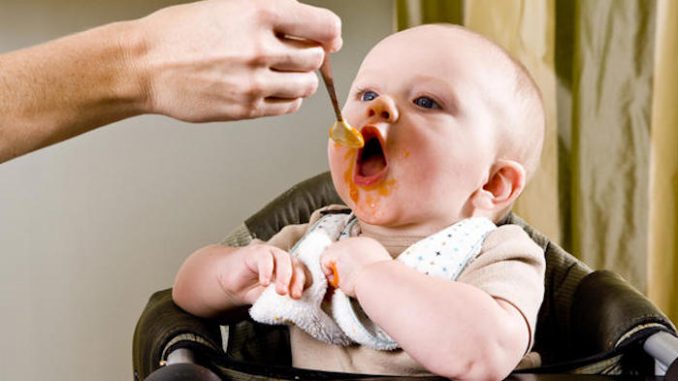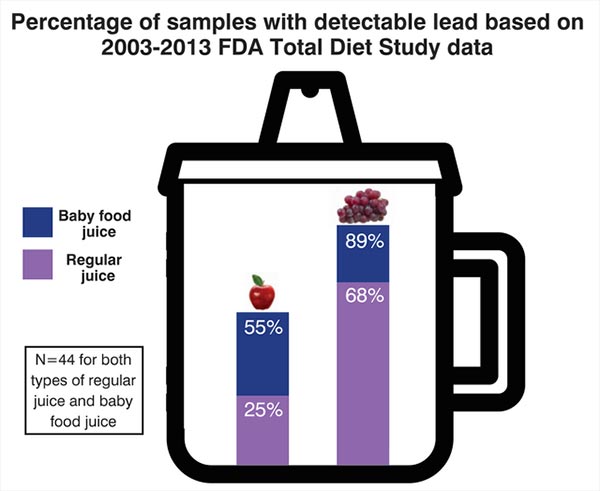
The FDA is allowing dangerous levels of lead to enter children’s bloodstreams, according to a new study that found 20% of baby food products in the US contain damaging levels of lead.
There is no safe level of lead in blood. In children, even very low blood lead levels can cause behavioral problems and lower IQ. Protecting children’s ability to learn and thrive demands that we find effective ways to reduce exposures to lead from all sources.
Environmental Defense Fund (EDF) analyzed 11 years of data from the Food and Drug Administration (FDA), and found that food, and baby food in particular, is a meaningful – and surprising – source of lead.
Key findings
EDF‘s analysis of 11 years of FDA data found:
- Lead was detected in 20% of baby food samples compared to 14% for other foods.
- Eight types of baby foods had detectable lead in more than 40% of samples.
- Baby food versions of apple and grape juices and carrots had more samples with detectable lead than the regular versions.
EDF also found that the FDA’s lax policies allow more than 1 million American children consume more lead than FDA’s limit. It has been estimated that by eliminating lead in food, and protecting children from neurological damage, society would save more than $27 billion annually in total lifetime earnings from saved IQ points.
Infants are incredibly vulnerable to lead
EDF evaluated data collected and analyzed by the Food and Drug Administration (FDA) from 2003 to 2013 as part of the agency’s Total Diet Study (TDS). Since the 1970s, the TDS has tracked metals, pesticides, and nutrients in food. While they evaluated all types of food collected by FDA, they focused on types of baby food because infants are most vulnerable to lead.
What EDF found
Overall, 20% of 2,164 baby food samples and 14% of the other 10,064 food samples had detectable levels of lead. At least one sample in 52 of the 57 types of baby food analyzed by FDA had detectable levels of lead in it. Lead was most commonly found in the following baby foods types:
- Fruit juices: 89% of grape juice samples contained detectable levels of lead, mixed fruit (67%), apple (55%), and pear (45%)
- Root vegetables: Sweet potatoes (86%) and carrots (43%)
- Cookies: Arrowroot cookies (64%) and teething biscuits (47%)
They also found that the baby food versions of apple and grape juice and of carrots had samples with detectable lead more often than the regular versions.

Recommendations
Both the FDA and food producers can and must do better to reduce lead in food, especially baby food in order to protect our children from irreversible developmental damage. The current state of affairs is simply not good enough.
EDF recommends that FDA:
- Ensure lead is not added to any food contact material where it is reasonably expected to get into food;
- Make clear that the international standards for fruit juice are inadequate;
- Update its limits and food safety guidance to reflect current scientific understanding of lead risks that better protect children; and
- Encourage manufacturers to reduce lead levels in food and take enforcement action when limits are exceeded.
Manufacturers need not wait for FDA to act. EDF recommends companies:
- Set a goal of less than 1 ppb of lead in baby food and other foods marketed to young children;
- Continue to prioritize lead contaminant minimization when sourcing ingredients;
- Test more frequently during processing to identify additional sources of lead and take appropriate corrective actions; and
- Publicly commit to consumers to drive down lead levels through health-protective limits and robust product stewardship.
What can parents do?
In the meantime, parents of young children should consult with their child’s pediatrician to learn about all the ways to reduce lead exposure. They should also check with their favorite brands to ask whether the company:
- Regularly tests its products for lead; and
- Ensures that, especially for baby food, there is less than 1 ppb of lead in the food and juices they sell.
Healthy eating requires safe, nutritious food. Lead has no place in a child’s diet.
Source Article from http://yournewswire.com/lead-baby-food/
 RSS Feed
RSS Feed















 June 18th, 2017
June 18th, 2017  Awake Goy
Awake Goy 
 Posted in
Posted in  Tags:
Tags: 













